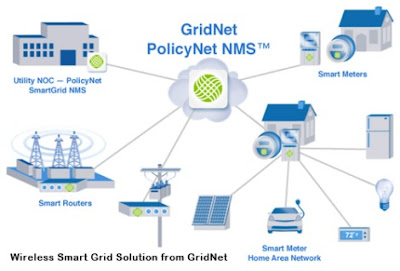Monday, June 14, 2010
The Future of Wireless Broadband: CommunicAsia 2010
Monday, June 7, 2010
New Strategies in the War Between Cisco and Juniper
Monday, May 17, 2010
Motorola Making Wireless Smart Grid Solutions
Tuesday, April 27, 2010
10 Ways To Get The Most From Your IT Training

Tech Republic has an excellent piece on how to get the most out of your IT training. It's worth reading in full, but here are the main points, briefly:
- Take advantage of on-the-job training whenever possible
- Go back to school for more extended learning
- Learn from the experts
- Use self-paced, online training for greater flexibility
- Use training that includes online lab simulations for practical experience
- Test yourself with practice exams to find out where you have knowledge gaps
- Practice on physical hardware if it’s available to you
- Use training that follows IT certification course requirements exactly
- Use training that tracks every action and scores results accordingly
- Overall, focus on the fundamentals
Tuesday, March 30, 2010
Cisco and Bank of America: Videoconferencing Giants

BusinessWeek has a great article about Cisco, HP, and Bank of America. It outlines the differences between Cisco's and HP's strategies for the fast-growing videoconferencing market, and it goes over details of a recent massive agreement between Cisco and Bank of America.
Basically, HP's videoconferencing solution is called is Halo Telepresence Solutions, which it developed with DreamWorks Animation back in 2005. DreamWorks has since then collaborated with HP on videoconferencing, including for creating the film How To Train Your Dragon. The HP Halo solution is geared more toward creative, fast collaboration. DreamWorld CTO Ed Leonard has said that HP's technology has allowed his studio to create films at its breakneck pace, three a year.
Cisco's videoconferencing products have also garnered high praise from high places. Proctor and Gamble Co. has stated that the company saved $4 for every $1 it spent on Cisco's TelePresence solution, which is good because the company installed 70 units. Each unite can cost more than $250,000. Proctor and Gamble said it saved money by reducing travel costs and increasing efficiency.
Now, Cisco is announcing its largest corporate partnership, yet. Bank of America plans to install 200 Csco TelePresence videoconferencing systems by the end of 2010. Presently, the banking giant uses 28 systems for employee meetings and training. Cisco's TelePresence solution will allow as many as 48 locations to collaborate simultaneously. As the workforce and economy spreads out on a global scale, this sort of massive videoconferencing solution will become more and more common. As for right now, it sure is exciting.
Posted by
Data Networking & Telecom Guys
at
10:17 AM
0
comments
![]()
Labels: bank of america, cisco, hp, videoconferencing
Thursday, March 18, 2010
Cisco Borderless Networks Released in the Wild?
Back in October 2009, Cisco announced a plan to launch its Cisco Borderless Networks. Recently, the company announced the release of its Cisco Borderless Networks line. This new product direction is aimed at supporting increasingly mobile businesses with distributed, in-the-field networking needs. Cisco Borderless Networks is designed to securely connect business workers to anything, anywhere, and anytime. Cisco delivers on this architecture through video, energy management and highly secure networking services that are embedded across its routing, switching, wireless and security platforms to form a comprehensive borderless networking solution.
An interesting aspect of this new line of Cisco products is that the company is makings its prices. We mentioned yesterday that the competition between HP and Cisco is heating up. This could be a concession or a new salvo, in that battle.
Some highlights of the Cisco Borderless Networks products include a much expanded switching line. The Cisco Catalyst 3750-X and 3560-X, the flagship of the Cisco fixed-switching portfolio. They are enterprise-class stackable and standalone these enterprise-class switches. The company also updated its router line.The Cisco Integrated Services Router G2 3900 E-Series was introduced last year in October. Cisco's latest announcement, though, includes the fact that they have tripled the performance of its ISR G2 router line. The line is now more than capable of handling challenging video applications and service integration.
These new Cisco products are an exciting addition to the networking marketplace. Competition is a good thing.
Posted by
Data Networking & Telecom Guys
at
6:47 AM
0
comments
![]()
Labels: cisco, cisco borderless networks
Wednesday, March 17, 2010
Cisco versus HP

Cisco and Hewlett-Packard are vying neck and neck for the valuable corporate data center market, but their leaders couldn't be more different. Whereas Cisco's John Chambers is known as a charismatic leader with a style similar to a southern preacher, HP's Mark Hurd is a by-the-numbers guy who excels at running operations. But obviously, both men have had a large amount of success.
Cisco dominates the market for networking and telecom systems. HP has a more diverse hardware portfolio, including computers, printers, servers, consulting, and software. The two companies, though, are starting to compete head to head as HP more fully enters the corporate market.
According to analysts, HP has seen its earnings grow over 22% per quarter on a year-over-year basis. Cisco has only seen 6% growth over a comparable period. HP's stock is also rising faster than Cisco's. Only time will tell which company assets its ultimate dominance.


